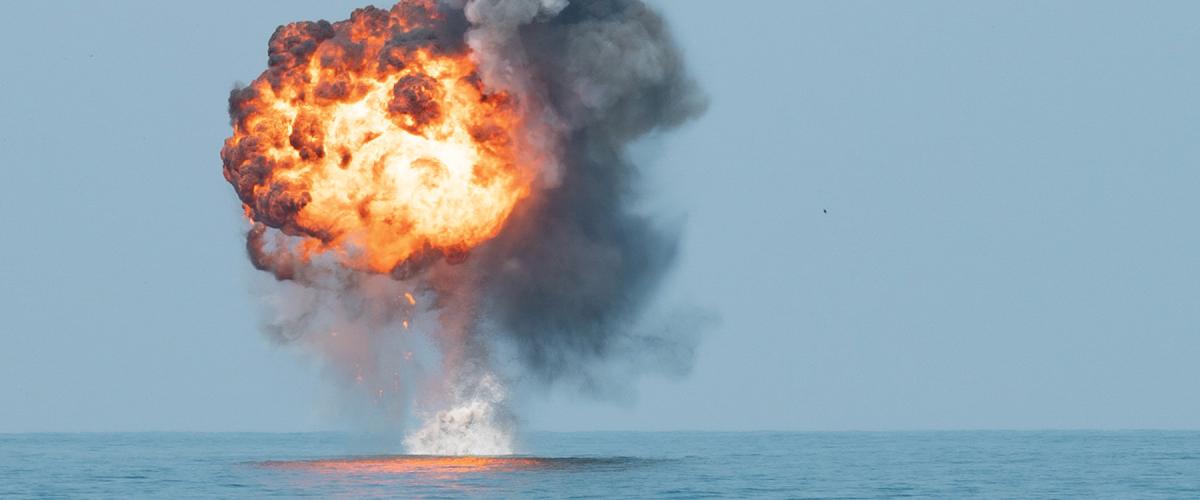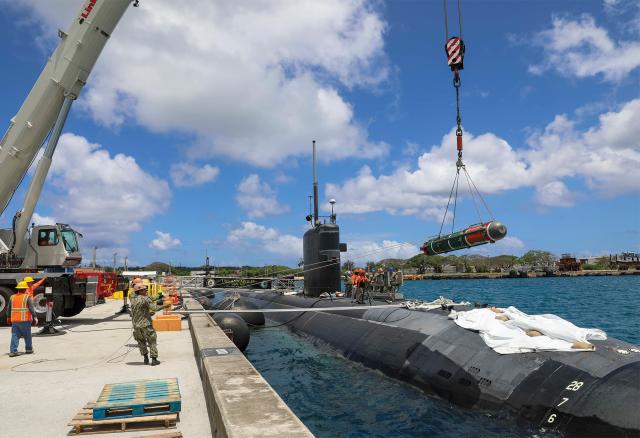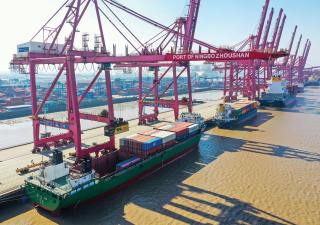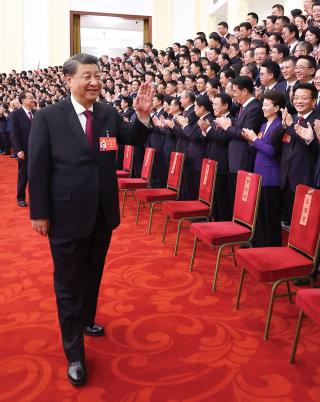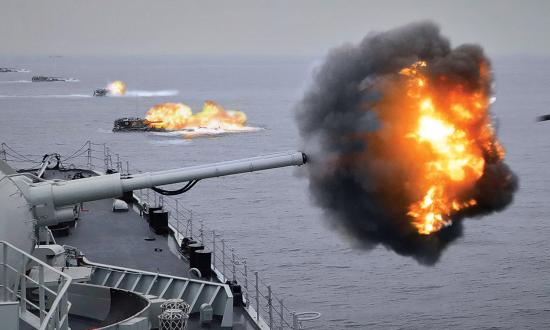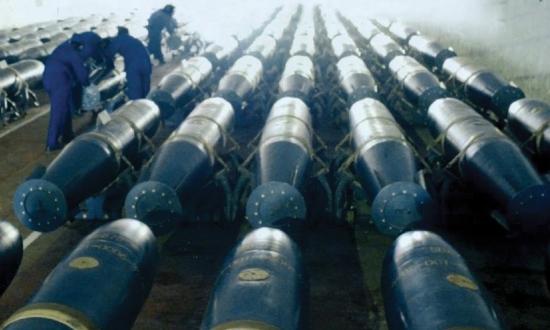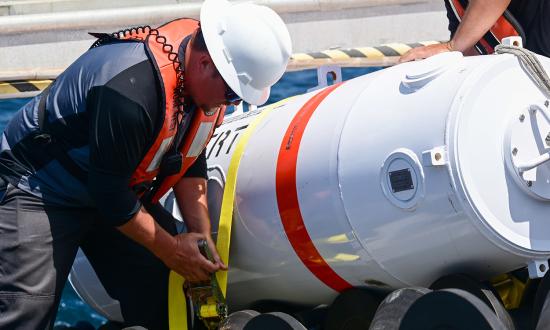Mines are perhaps the most pernicious and frustrating obstacle a ground or maritime force can face. They can halt an offensive or counteroffensive operation, funnel forces to where they are most vulnerable, or simply cut off trade.
These “weapons that wait” have long wielded their disproportionate impact. U.S. offensive mine warfare during Operation Starvation was a substantial factor in the Japanese defeat in World War II, sinking more than a million tons of shipping. The only five U.S. Navy vessels sunk in combat during the Korean War were lost to mines. Three U.S. warships were mission kills in the Arabian Gulf as a result of Iraqi or Iranian mines, and mines were one reason an amphibious assault was not included in the liberation of Kuwait. More recently, floating mines in the Black Sea have disrupted both naval operations and Ukrainian grain exports. These diabolical weapons have enormous potential to influence future conflicts.
Unfortunately, at this pause point in the American Sea Power Project scenario, offensive mine warfare is largely foreclosed as an option, the result of an overarching strategic concept that undervalues offensive maritime mine warfare and decades of inattention on the part of the U.S. Navy. It is not surprising that the People’s Liberation Army Navy (PLAN) would control the South China Sea, the Taiwan Strait, and areas around Taiwan or that the PLA would have established a lodgment on the island.
This would not have to happen. Were the U.S. government and its joint military force to adopt a different strategic approach to this conflict, even a mine warfare stable that currently lags those of other nations could be a significant—and economically and militarily efficient—contributor to deterring or defeating Chinese aggression. More advanced mining capabilities could be decisive.
The Program of Record
In addition to having assets in position when needed, effective offensive mine warfare requires two key capabilities: the weapons themselves and the means to deliver them. Based on available unclassified information, the Navy’s program of record around 2026 for the former will include a combination of:1
• Mk 67 Submarine Launched Mobile Mines (SLMMs). These modified Mk 37 Mod 2 torpedoes have an attached mine target-detecting device and can be delivered by a submarine from a standoff range of approximately eight miles. They work only in shallow water.
• Mk 62 and 63 Quickstrike mines—converted general purpose 500- and 1,000-pound bombs—and Mk 65s, 2,300-pound mines that use a special case. These mines work only in shallow water, triggered by acoustic, seismic, or pressure signatures. The Quickstrike-Extended Range (ER) mine can glide approximately 40 miles when dropped from 35,000 feet. It is not clear how many of these mines exist, where they are stored, and thus how readily available they are.
• Hammerhead and Clandestine Delivered Mines currently being developed by the Navy. The former is meant to replace the older Mk 60 CapTor mine and would be deployed from a submarine. Using a torpedo, it would function in deeper water. The latter would allow legacy mining systems to be delivered by unmanned undersea vehicles. However, it is unlikely either system will be available in theater by the scenario’s 2026 conflict.
Regarding delivery, the current options are fairly limited:
• The SLMM can be delivered only by an Improved Los Angeles–class submarine. It is unlikely that at the outset of the 2026 scenario any of the 13 of these submarines stationed in the Indo-Pacific (five homeported in Guam) would be loaded with any substantial quantity of these mines. Given the current operational concept, these submarines—packed with torpedoes, not mines—will be in demand to conduct other missions (see “You Can’t Win Without [More] Submarines,” pp. 38–45). Loading mines on board after a conflict begins would require considerable time, including transit to a loading pier, torpedo offload and SLMM onload, and transit back to the theater. The scenario suggests performing this extended evolution in Guam would be hazardous.
• Quickstrike munitions are air-delivered by B-52s, B-1s, B-2s, P-8s, and F/A-18s. The B-21 also should be able to deliver mines, but it will not be available at scale in 2026. The conventional Quickstrike must be delivered under benign, low-altitude conditions—difficult this late in the scenario when the PLA maintains air superiority over its own waters and likely over Taiwan. Even with the Quickstrike-ER, flying anything other than a stealthy aircraft inside the hot zone would be extremely high risk. It is questionable whether B-2s would be available this late in the scenario given amplified concerns over nuclear deterrence and Chinese perceptions.
• The Navy is developing the Orca Extra Large Unmanned Undersea Vehicle (XLUUV), an 85-foot unmanned submarine with a 34-foot modular payload compartment. One of the Orca’s principal missions will be delivering mines, presumably the Clandestine Delivered Mine. The Navy also has published a request for information for a Mining Expendable Delivery Unmanned Submarine Asset (MEDUSA) “to meet future submarine delivery of payloads requirements.” MEDUSA will be a tactical clandestine mining system with an expendable unmanned underwater vehicle that can launch from a submarine’s torpedo tube. It is doubtful either of these systems will be fielded in an operationally effective quantity by the 2026 scenario.
It appears the 2026 American Sea Power Project conflict stemmed from Chinese Communist Party (CCP) leaders’ belief that regional and geopolitical factors had forced their hand and that the PLA’s ability to conduct an invasion was far enough along to succeed. Unfortunately, based on the joint force’s mining programs and operational configuration and readiness, it probably is too late to deploy offensive mining in any meaningful way at the pause point.
‘Tactics Without Strategy Is The Noise Before Defeat’
The scenario reflects a warfighting environment in the western Pacific that has deteriorated significantly. The United States took its eye off the problem over the past two decades, but China did not rest. In addition to its advantages in geography and initiative, it devoted nearly all its military investments to keeping the United States and its allies out of its backyard and developing the ability to coerce its neighbors. Analyses and wargames consistently demonstrate that China has progressed in this effort and that a conflict could be long and costly.
Yet, as the environment has changed, the U.S. joint force has clung to a longstanding strategic concept—namely, old-fashioned force-on-force overmatch, with the Chinese military as the center of gravity. The scenario’s stalemate suggests the need for the United States to evolve its current strategic concept to one that uses all elements of national power to hold at risk the CCP’s ability to maintain its grip on power.
One vector of an evolved approach would use the military instrument to attempt to deny the objectives of PLA forces attacking Taiwan, but it would do so using means that are less expensive and more survivable. The strategy’s other important vector would impose costs on China using other elements of power, including diplomatic, informational, and especially economic. The scenario hints at the importance of the latter element when stating that “securing free trade while interrupting that of the enemy will be of the highest importance.”
Both vectors would pose a threat to the “Mandate from Heaven” granted to the CCP by its population, which is what the party fears the most.2 China’s ubiquitous state surveillance, the rapid relaxation of heavy-handed COVID-19 quarantine policies when the population became restless, and the more recent concealment of rising youth unemployment numbers are clear signs of this paranoia. Heavy military losses alongside steep economic effects would place the CCP under tremendous pressure. An economy suffering under the burden of Chairman Xi Jinping’s authoritarian leadership renders it even more vulnerable to this approach.
‘Strategy Without Tactics Is the Slowest Route to Victory’
A key element of this evolved approach is interdicting Chinese military and commercial shipping both inside and outside the active zone of combat quickly and at the lowest possible cost.
Doing so outside the hot zone lends itself well to existing U.S. naval forces, though they would need to be reconfigured for a (possibly) opposed commerce interdiction mission.3 The intent would be to interdict the 60 percent of Chinese commerce—including war-supporting goods such as petroleum—that travels by sea.4 However, as the Russian Navy has learned in the war against Ukraine, operating exposed naval forces inside the hot zone is extremely hazardous, which suggests less emphasis on using such forces.
Enter underappreciated and unglamorous mine warfare. Assisting Taiwan in defensively mining its own waters and, once conflict starts, offensively mining the 30-plus major (and hundreds of minor) Chinese ports using survivable delivery assets would match well with an evolved strategy that minimizes exposure of assets in the hot zone. Mining Chinese waters before the first PLAN vessels leave port would be a casus belli to be avoided. However, closing these ports, all of which could be used for military purposes, shortly after the beginning of conflict would impose a major physical and psychological impediment to China’s ability to maintain sea control and deploy and sustain its ground forces. Blocking these ports to prevent their use for military purposes also would have the incidental yet important effect of shutting down a major element of China’s commercial lifeline.5
Indeed, in conformance with customary international law, this mining principally would serve the deny objectives vector of the strategy. It is similar to the justification used when the United States mined North Vietnamese ports in 1972. The Convention Relative to the Laying of Automatic Submarine Contact Mines, also known as Hague VIII, prohibits belligerents from laying “automatic contact mines off the coast and ports of the enemy, with the sole object of intercepting commercial shipping.”6 But “mining for some other purpose—strategic blockade of enemy ports, coasts, and waterways—is permissible even if commercial shipping is incidentally affected.”7 Thus, mining could be used to impose costs on China for its belligerence.
Using current capabilities, a mining operation could be conducted along three principal pathways.8 First, Improved Los Angeles–class submarines no longer would be packed with torpedoes intended to protect U.S. aircraft carriers and surface ships (which would avoid the hot zone) or interdict Chinese military shipping in the Taiwan Strait. That mission would be left to the Virginia class. Rather, they would be assigned to deploy mines against Chinese ports and would carry only enough torpedoes for self-defense. Submarines already on station would quickly deploy their mines; those needing to sortie would be preloaded with mines.
Also, early in the conflict, B-2 sorties above those required for normal deterrent readiness could be assigned to seed additional Chinese ports with Quickstrike-ER mines, before nuclear escalation becomes a concern. Even short warning times would be adequate to quickly load and station these aircraft for their initial sorties if the right preparations were made. A single B-2 can carry 80 500-pound general-purpose bombs and presumably the same number of Quickstrike mines. A concentrated campaign would commence by mining the most important military ports and over a few days could severely affect ship movements. Even though Chinese forces could track some air-delivered mines as they landed, it takes much longer to sweep mines than to lay them, and they could be reseeded as necessary.
It is also worth leveraging the mining capabilities of allies and partners. Taiwan has procured at least four Min Jiang–class minelayers, though its intentions for procuring more-modern mines than the World War I–era Mk 6s the United States provided years ago are unclear. Unfortunately, while Taiwan’s most recent national defense report states it will refine “the minelaying tactics to curb the enemy’s intent to launch an amphibious invasion,” nowhere does it mention either acquiring advanced mines from other countries or producing its own.9 Key allies such as Australia, which is investing heavily in advanced sea mines specifically with an eye on China, would be more likely to participate in defensive mining for Taiwan than offensive mining against China, but that still would be an important contributor to denying Chinese aggression.10
But Tactics Without Technology Are Toothless
As it evolves its strategic concept and tactics for this conflict, the Navy should continue to accelerate its existing efforts to enhance mine warfare systems. An important and immediate step would be to include jet propulsion in Quickstrike-ER kits to extend the mines’ range and lower their delivery altitude. This would add to the types (and therefore numbers) of Air Force and Navy aircraft able to deliver these mines from a survivable distance and render them harder to detect during delivery.
This could be done by a number of defense suppliers, large and small, and would resonate with the “Replicator” initiative announced by Deputy Defense Secretary Kathleen Hicks in August 2023.11 The service also should develop additional means to exercise control over these mines, which would provide more operational flexibility and comply even more closely with customary international law.
In the longer term, the Navy should develop high-technology mine-like devices that adhere to Department of Defense guidelines for semi-autonomous operation, using:12
• Acoustic discrimination empowered by machine learning, with accumulated training data continuing to refine the fidelity of identification solutions
• Semiautonomous, artificial intelligence–enabled, engagement decision-making that accounts for geometries, neighboring mines’ status, and situationally dependent instructions
• Redundant, secure, two-way communication to pass warfighting instructions, software and library updates, acoustic reporting to augment algorithms, situation and status updates, and engagement reporting
• Multiple sensor types
• Long-life batteries and rechargeability
• Long-range or deeper water engagement using a small torpedo, such as the Compact Rapid Attack Weapon (CRAW), which would enable mining in deeper water in the Taiwan Strait
• Stealthy, hard-to-sweep configurations
Thinking Differently
While the United States in peacetime poses no threat to China’s regime, and the war described in the American Sea Power Project scenario may be unlikely in the near term—a host of factors would have to combine to make it real—it is vital that such a conflict never be fought. Nonetheless, the United States should consider an evolved approach to deterring war that focuses closely on the CCP’s leaders, exploiting—among other vectors—their concerns over China’s military and commercial shipping being bottled up in ways that would both inhibit its military attack and affect its economy.
Under an evolved strategy, offensive mine warfare should gain far more prominence in U.S. sea power thinking than it has had in the past, which suggests the need to grant it a clean break from the communities that have alternately undernourished it over the years. This would better enable the investments needed to bring the right capabilities and tactics to bear. It also would require the creation of more senior officer billets in the community—at the expense of other communities—to form a more empowered force. This was done years ago for naval special warfare, and it has worked extremely well.
This discussion did not include countermine warfare because offensive mine warfare and countermine warfare should be distinct entities, with the latter remaining under the purview of surface warfare. Lumping these disciplines together simply because they both have the word “mine” in their names makes no more sense than doing the same with missile defense and offense.
Max Boot has rightly labeled the war in Ukraine a “laboratory of warfare.” Its implications for the American Sea Power Project scenario’s maritime-intensive war fall not only in showcasing specific systems (such as drones and small, smart weapons) but also in highlighting the persistence of change and the need for agility. Offensive mine warfare—in both its current and potential instantiations—offers an opportunity to present new dilemmas to those who would threaten U.S. vital interests, but only if we quickly recapitalize this disruptive, historically proven capability before it is too late.
1. There are numerous unclassified sources of information on Navy offensive mine warfare programs, including Megan Eckstein, “U.S. Naval Offensive Mining Updates Will Focus on Sub Community Tactics, Smart Mines,” USNI News, 5 November 2019; and David Strachan, “In the Navy: The Role of Advanced Sea Mines in Future Conflicts,” Marine Technology, 28 March 2023.
2. The fragility of the “Mandate from Heaven” is well described by Fernand Braudel, A History of Civilizations (New York: Penguin Books, 1993), 186–87.
3. For example, a squadron of littoral combat ships loaded with Marine Corps boarding teams, perhaps commanded by a Marine officer, covered by conventional air power and appropriately loaded surface combatants, could move quickly to interdict merchant ships in the Indian Ocean and elsewhere.
4. China Power Team, “How Much Trade Transits the South China Sea?” China Power, ChinaPowerCSIS.org, 2 August 2017, updated 25 January 2021.
5. There are other obligations levied on a nation laying maritime mines in an opponent’s waters, such as notifying all parties so neutral vessels may remain clear, attempting to track the mines’ positions, and ensuring the mines are disabled when they no longer can be controlled.
6. The Convention refers only to contact mines, which are not in use by the United States. However, customary international law accepts that Hague VIII refers to all maritime mines.
7. Raul (Pete) Pedrozo, “Dangerous Waters: Use of Naval Mines in the Russia-Ukraine Conflict,” guest post by Charlie Dunlap, Lawfire, 15 June 2022.
8. For a more detailed discussion on a mining campaign in the Taiwan Strait, see Matthew Cancian, “An Offensive Minelaying Campaign against China,” Naval War College Review 75, no. 1 (Winter 2022).
9. 2023 Taiwan National Defense Report, available from USNI News, 13 September 2023.
10. Australian Ministry of Defence, “Australia Procures New Smart Sea Mines,” press release,Naval News,29 August 2023.
11. Noah Robertson, “Pentagon Unveils ‘Replicator’ Drone Program to Compete with China,”Defense News, 28 August 2023.
12. For more information on the potential for these devices, see ADM James Winnefeld Jr. and CAPT Syed Ahmad, USN (Ret.), “The Other Mine Warfare Will Work,” U.S. Naval Institute Proceedings 144, no. 7 (July 2018); and ADM James A. Winnefeld, USN (Ret.), “AI Surprise in the Black Ditch,” U.S. Naval Institute Proceedings 147, no. 1 (January 2021).



